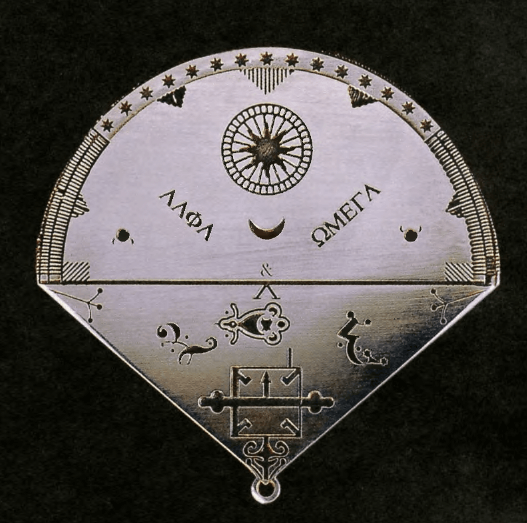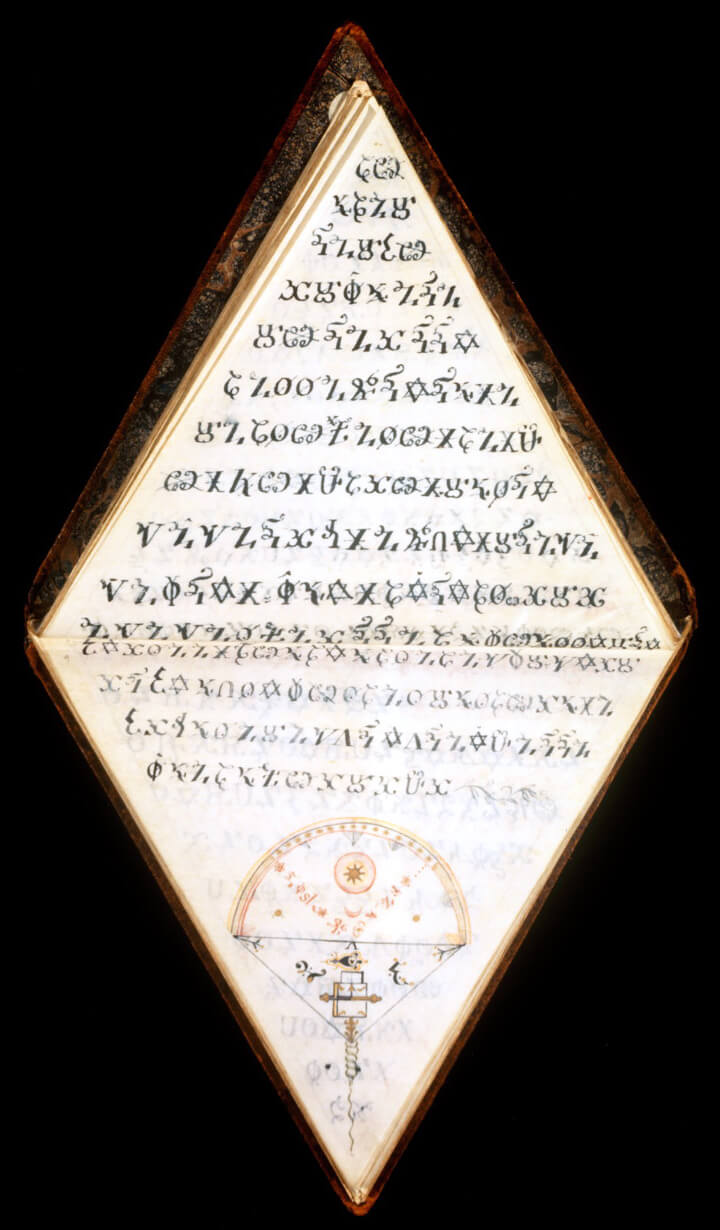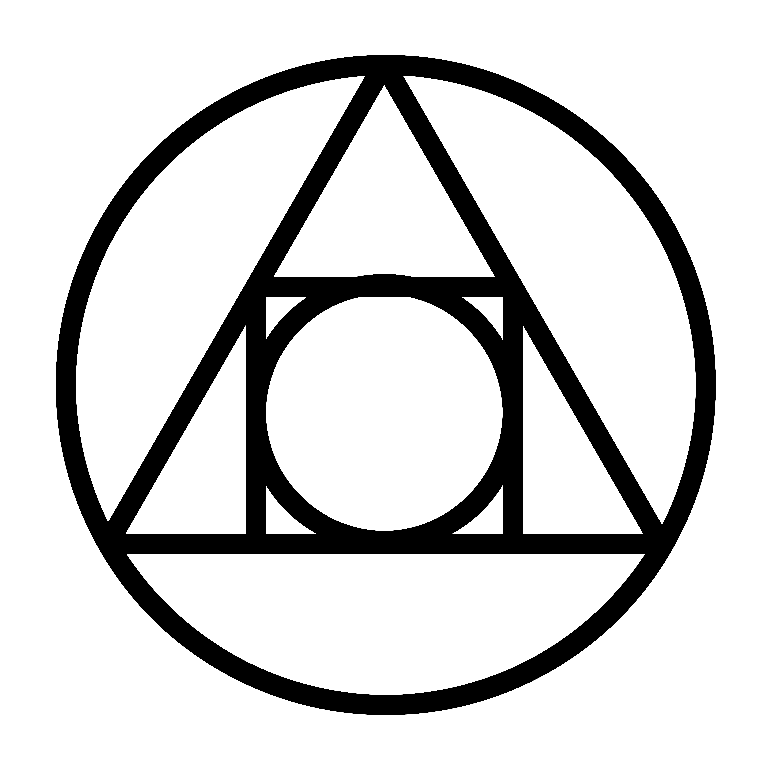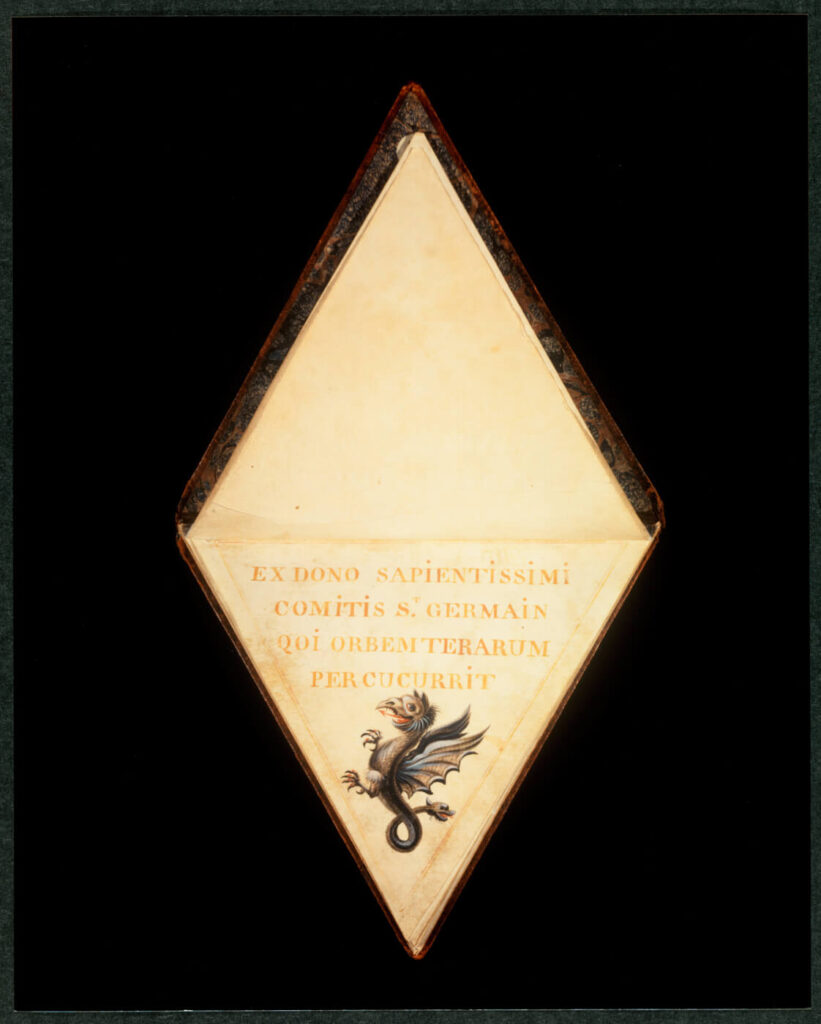Saint Germain’s Triangular Book: The Ritual Explained
(An analysis of the ritual geometry, names, and aims across MS 209, 210, and Wellcome 4668)
Ritual Overview
The Triangular Book of Saint Germain presents a single ceremonial structure that promises three distinct outcomes. The rite unites geometry, invocation, and material craft. It calls for a double circle drawn on the ground, the operator seated within the smaller, and a second participant—called the Levite—stationed in the outer ring. The two circles are joined by a small triangle, the emblem of revelation.
Each operation begins with the consecration of a vessel of fire, the blessing of incense and four lamps, and the preparation of a thin brass lamina on which revealed characters are to be traced. The text insists that the practitioner observe astronomical timing: treasure-seeking only during a conjunction of Sun, Moon, and Earth; the longevity working at any hour, provided the Figure (talisman) is carried upon the person.
The Three Aims
-
Recovery of things lost at sea – “since the overthrow of the globe.”
-
Discovery of mines and precious stones – “in the entrails of the earth.”
-
Preservation of health and the extension of life – “to one hundred years, with the strength and freshness of fifty.”
These aims follow the same liturgical form: purification of fire and light, recitation of divine names, invocation of directional spirits, listening for inspiration, and sealing the received message on brass.
The Flood and the Overthrow of the Globe
Across myth and geology, the “overthrow of the globe” echoes a memory both physical and metaphysical.
Alchemists spoke of the world’s dissolution before renewal; scriptures remembered it as the Flood.
In the Triangular Book, Saint Germain’s phrase “depuis le renversement du globe” points to this
cataclysm—an event that erased civilizations and concealed their wisdom beneath the sea.
Modern science names the same rhythm in ice-age melts, volcanic winters, and cosmic impacts:
cycles that drown coastlines and force new beginnings.
Each retelling—Noah’s Ark, Deucalion, Manu, or Utnapishtim—marks the mind’s attempt to
record that upheaval.
To the alchemist, these floods were not punishments but
necessary dissolutions, the planetary nigredo before regeneration.
Thus the first aim of the ritual—to recover “things lost in the seas since the overthrow of the globe”—
is more than treasure seeking.
It is the search for fragments of the pre-diluvian mind, the scattered light of the
world that was, waiting to be re-coagulated into wisdom once more.
Preparations
The operator lights the prepared fire and proclaims the exorcism:
O creature of Fire, I exorcise thee by Him by whom all things were made…
The Levite answers Amen. Incense and lamps are then blessed “that their virtue may increase the fear of their enemies.” Both stand robed as for sacrifice. The operator holds the Figure in the left hand while entering the inner circle; the Levite bears the characters of revelation—inscribed symbols or tablets—to his appointed station.
Names and Directions
The manuscript orders the invocation of spirits by the quarters of the circle:
Names and Directions
East
- LEAMAN
- LECIAB
- LATRANAVIO
- RIBRAL
- TELARO
West
- ELANA
- LEPAB
- USTAEL
- THAERRUB
- SOTARECO
- ILIBAPAC
Upper Arc
- ELIA
- ELINA
- AMIGABIREL
Lower Arc
- PEDINBAD
- FIALECHAM
- CHARSIEL
After this enumeration, the operator prostrates toward the east and utters the principal prayer—an appeal for divine guidance in locating treasures, revealing metals, or lengthening life—“by the Names of the Eternal,” among which NOTAMARGATET, IANODA, AGLA occur most often.
Variant note: NOTAMMARGATEL appears in MS 210 and Wellcome 4668, while MS 209 gives NOTAMARGATET; all three preserve the same sequence of phonemes, suggesting transliteration rather than error.
The Figure

The Figure—later reproduced as a silver triangular talisman—is the ritual’s central instrument.
-
In the longevity operation, it is “carried upon the person.”
-
During invocation, it is “placed upon the head by the left hand.”
The drawing shows celestial symbols (Sun, Moon, stars) above a wedge of terrestrial signs; at its perimeter run the words Alpha and Omega, completing the circle of creation. Historically this figure was likely drawn on parchment or thin brass; later artisans, reading the text talismanically, cast it in silver, the lunar metal of preservation.
Variant: MS 209 renders the figure in red and gold inks; MS 210 reduces it to line work; Wellcome 4668 copies only the key without color.

Brass Inscription
When inspiration descends, the operator must listen “with attentive ear” and trace from right to left on a brass plate the characters heard. The action symbolizes inversion—Spirit entering Matter. Brass, an alloy of copper and zinc, was chosen for endurance and its dual planetary virtue (Venus for vitality, Mercury for communication). The inscribed plate becomes a material witness of the revelation, sealed and kept as proof of divine favor.
Variant Notes
Variant Notes (Manuscript Camparison)
Cipher Key
- MS 209: Complete but inconsistent; duplicates H, I, S, Y.
- MS 210: Cleaner glyphs; K omitted, X penciled later.
- Wellcome 4668: Most accurate; includes marginal French/English glosses.
Divine Names
- MS 209: NOTAMARGATET
- MS 210: NOTAMMARGATEL
- Wellcome 4668: NOTAMMARGATEL
Layout
- MS 209: Triangular codex; illuminated.
- MS 210: Rectangular; plainer.
- Wellcome 4668: Rectangular; study copy.
Material Marks
- MS 209: Gold and red inks.
- MS 210: Black ink only.
- Wellcome 4668: Ink with pencil corrections.
FAQ
What is a “Levite”?
A ritual assistant, echoing the biblical temple servant. Here he answers Amen, tends fire and lamps, and acts as witness.
Why two uses of the Figure?
The text distinguishes carry upon the person (daily protection) from place upon the head (moment of invocation).
Why is the talisman silver in replicas?
Silver symbolizes purity and lunar vitality; the manuscripts never specify metal, but later esoteric orders favored silver for durability.
Does the book promise immortality?
No. It promises one century of vigorous life—extended longevity, not deathlessness. The legend of Saint Germain’s immortality arose later from this teaching.
Why write right-to-left?
The gesture mirrors Hebraic sacred writing, asserting reversal between divine and human realms.
Provenance Summary
-
MS 209 – Getty Research Institute (Manly P. Hall Collection), triangular codex with colored figures.
-
MS 210 – Private lineage noted by Nick Koss, includes cipher key.
-
Wellcome 4668 – Wellcome Collection, London, with parallel notes and watermark fragment.
References & Further Reading
- The Triangular Book of St. Germain, Ouroboros Press, 2014 — annotated edition by Nick Koss with translation and ritual commentary. triangularbook.com.
- Getty Research Institute, MS 209 (Manly P. Hall Collection) — primary source manuscript, gold and red ink triangular codex.
- Wellcome Collection, MS 4668 — variant manuscript with cipher key and marginal English notes.
- Waite, A.E., The Hermetic Museum (1893). Archive edition via Archive.org.
- Yates, Frances A., The Rosicrucian Enlightenment (Routledge, 1972) — context for 18th-century Hermetic ritual systems.
- Churton, Tobias, The Magus of Freemasonry: The Mysterious Life of Elias Ashmole (Inner Traditions, 2006) — on overlapping Masonic and alchemical traditions.
- Klossowski de Rola, Stanislas, Alchemy: The Secret Art (Thames & Hudson, 1973) — on ritual symbolism and geometric diagrams in alchemical art.

